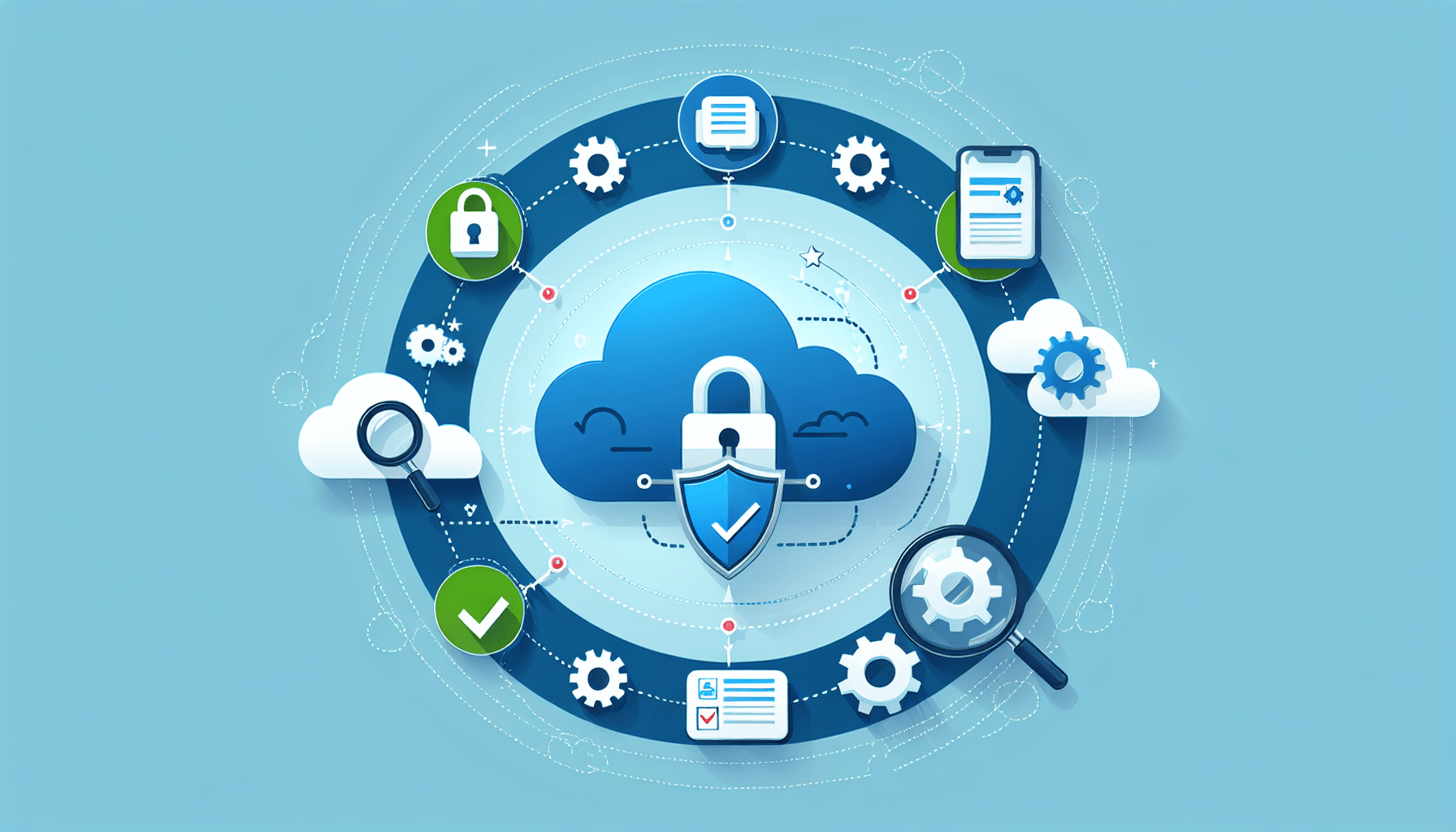In today’s ever-evolving digital landscape, the importance of robust cybersecurity measures cannot be overstated. With organizations increasingly relying on cloud computing services to store and access their valuable data, ensuring the security of this information has become paramount. This article explores the significance of conducting regular cloud security assessments, highlighting the potential risks associated with inadequate protection and emphasizing the critical need for ongoing evaluation and improvement in this crucial aspect of modern business operations.
Overview of Cloud Security Assessments
What is a cloud security assessment?
A cloud security assessment is a systematic evaluation of the security measures and protocols in place within a cloud environment. It involves analyzing and identifying potential security risks, vulnerabilities, and threats, and assessing the effectiveness of existing security controls. The assessment aims to ensure the confidentiality, integrity, and availability of data and systems within the cloud.
Why are cloud security assessments necessary?
Cloud security assessments are necessary to safeguard digital assets and protect against potential security breaches. As more organizations migrate their data and applications to the cloud, it becomes essential to assess the security posture of the cloud environment. Cloud services are vulnerable to a wide range of threats, such as unauthorized access, data breaches, and denial-of-service attacks. Regular assessments help organizations identify and address these security risks proactively.
Benefits of regular cloud security assessments
Regular cloud security assessments provide several benefits to organizations. Firstly, they help identify and prioritize assets and potential risks, ensuring that resources are allocated efficiently for security. Assessments also evaluate the effectiveness of existing security controls and identify any gaps that need to be addressed. By assessing vulnerabilities and threats, organizations can understand their exposure and take appropriate measures to mitigate risks. Testing incident response and disaster recovery procedures ensures that organizations are prepared for potential security incidents. Furthermore, regular assessments confirm compliance with industry standards and regulations, instilling trust and confidence in customers and stakeholders.
Key Components of a Cloud Security Assessment
Identifying and prioritizing assets and potential risks
In a cloud security assessment, the first step is to identify the assets within the cloud environment and evaluate their value and importance to the organization. This includes assessing data, applications, systems, and infrastructure. By understanding the assets, organizations can prioritize their protection efforts based on the level of risk associated with each asset.
Evaluating existing security controls
Assessing existing security controls helps organizations understand the effectiveness of their current security measures. This involves reviewing access controls, authentication mechanisms, encryption practices, and network security configurations. By evaluating these controls, organizations can determine if they meet industry standards and best practices, and identify any weaknesses or gaps that need to be addressed.
Assessing vulnerabilities and threats
In a cloud security assessment, vulnerabilities and threats are assessed to understand the potential risks faced by the cloud environment. This involves using vulnerability assessment tools to scan for known vulnerabilities and conducting penetration testing to simulate real-world attacks. By identifying vulnerabilities and understanding the threats that exploit them, organizations can take the necessary steps to remediate them and enhance their overall security posture.
Testing incident response and disaster recovery procedures
To ensure preparedness for security incidents, it is crucial to test incident response and disaster recovery procedures regularly. This involves simulating various security incidents and assessing the effectiveness of the response mechanisms in place. By evaluating incident response and disaster recovery procedures, organizations can identify any gaps or weaknesses, and make improvements to ensure a swift and efficient response to security incidents.
Reviewing compliance with industry standards and regulations
Compliance with industry standards and regulations is critical for maintaining the security and integrity of cloud environments. A cloud security assessment should include a review of compliance with relevant standards, such as the Payment Card Industry Data Security Standard (PCI DSS) or the General Data Protection Regulation (GDPR). By reviewing compliance, organizations can ensure that they meet the necessary requirements and avoid potential fines or penalties.

Importance of Regular Assessments
Detecting and mitigating potential security risks
Regular cloud security assessments help organizations proactively detect and mitigate potential security risks. By continuously assessing the cloud environment, organizations can identify vulnerabilities, misconfigurations, and potential threats before they are exploited. This enables prompt remediation and minimizes the impact of security incidents.
Ensuring compliance with evolving security standards
Security standards and regulations constantly evolve to address emerging threats and vulnerabilities. Regular cloud security assessments ensure that organizations stay compliant with these evolving standards. By conducting assessments on a regular basis, organizations can identify any gaps in their security practices and implement necessary changes to maintain compliance.
Identifying and addressing vulnerabilities in a timely manner
Vulnerabilities in cloud environments can be exploited by threat actors to gain unauthorized access or compromise sensitive data. Regular assessments help identify and address these vulnerabilities in a timely manner. By staying proactive and continuously assessing the security posture, organizations can patch vulnerabilities, update security controls, and minimize the likelihood of successful attacks.
Staying ahead of emerging threats and attacks
The threat landscape is constantly evolving, with new tactics, techniques, and vulnerabilities being discovered regularly. Regular cloud security assessments help organizations stay ahead of these emerging threats and attacks. By continuously evaluating the security posture, organizations can identify new attack vectors, assess their potential impact, and implement appropriate measures to defend against them.
Maintaining customer trust and confidence
Regular cloud security assessments demonstrate an organization’s commitment to data security and privacy. By regularly evaluating and improving security measures, organizations can maintain customer trust and confidence. Customers are more likely to trust organizations that prioritize security and regularly assess their cloud environments for potential risks.
Best Practices for Conducting Cloud Security Assessments
Establish clear objectives and scope for the assessment
Before conducting a cloud security assessment, it is important to establish clear objectives and define the scope of the assessment. This includes determining the assets to be assessed, the assessment methodology to be used, and the desired outcomes. Clear objectives and scope help ensure that the assessment is focused and effective in addressing the organization’s specific security needs.
Engage experts in cloud security assessment
Cloud security assessments can be complex and require specialized knowledge and expertise. Engaging experts in cloud security assessment helps ensure accurate and thorough assessments. These experts can bring in-depth knowledge of cloud security best practices, industry standards, and the latest threats and vulnerabilities. Their experience and expertise can greatly enhance the effectiveness of the assessment.
Use a combination of automated tools and manual analysis
To conduct comprehensive cloud security assessments, organizations should use a combination of automated tools and manual analysis. Automated tools can efficiently scan the cloud environment for known vulnerabilities and misconfigurations. Manual analysis, on the other hand, allows for a deeper understanding of the environment and its unique risks. By combining automated tools with manual analysis, organizations can obtain a more accurate and holistic assessment.
Consider the use of ethical hacking techniques
Ethical hacking techniques, such as penetration testing, can provide valuable insights into the security of a cloud environment. By simulating real-world attacks, organizations can identify potential vulnerabilities and test the effectiveness of their security controls. Ethical hacking techniques help uncover hidden weaknesses and provide actionable recommendations for improving security.
Document findings and recommendations
It is crucial to document the findings and recommendations from a cloud security assessment. This includes documenting identified vulnerabilities, risks, and weaknesses, as well as recommended remediation steps. Documentation ensures that assessment results are captured accurately and can be used for future reference. It also helps prioritize and track the progress of remediation efforts following the assessment.

Challenges Faced in Cloud Security Assessments
Complexity and scale of cloud infrastructure
Cloud environments are often complex and extensive, with numerous interconnected systems and services. Assessing the security of such environments can be challenging due to their scale and complexity. Organizations need to understand the intricacies of their cloud infrastructure and ensure that all components are adequately assessed.
Rapidly evolving threat landscape
The threat landscape is constantly evolving, with new vulnerabilities and attack techniques emerging regularly. This poses a challenge for cloud security assessments, as organizations need to stay updated on the latest threats and vulnerabilities. To address this challenge, organizations should continuously monitor the threat landscape and incorporate the latest threat intelligence in their assessments.
Lack of standardized assessment frameworks
There is a lack of standardized assessment frameworks specifically tailored for cloud security assessments. This can make it difficult for organizations to align their assessment practices with industry standards. To overcome this challenge, organizations should leverage existing frameworks, such as the Cloud Security Alliance (CSA) Cloud Security Controls Matrix, and customize them to suit their specific needs.
Ensuring cooperation and coordination among stakeholders
Cloud security assessments often involve multiple stakeholders, including IT teams, security teams, and cloud service providers. Ensuring cooperation and coordination among these stakeholders can be challenging, especially when conducting assessments across different cloud environments. Clear communication channels, collaboration platforms, and well-defined roles and responsibilities can help address this challenge.
Key Considerations for Choosing a Cloud Security Assessment Provider
Expertise and experience in cloud security
When choosing a cloud security assessment provider, it is essential to consider their expertise and experience in cloud security. The provider should have in-depth knowledge of cloud architectures, security controls, and best practices. They should be familiar with various cloud platforms and technologies, and have a track record of conducting successful cloud security assessments.
Ability to cater to specific industry and compliance requirements
Different industries have unique security requirements and compliance obligations. When selecting a cloud security assessment provider, organizations should ensure that the provider can cater to their specific industry and compliance requirements. This includes understanding the relevant regulations, such as HIPAA for healthcare or GDPR for data protection, and conducting assessments that address these requirements.
Use of advanced assessment methodologies and tools
Cloud security assessment providers should employ advanced assessment methodologies and tools to ensure comprehensive and accurate assessments. This includes using automated scanning tools, threat intelligence databases, and state-of-the-art penetration testing techniques. The provider should also stay updated on the latest advancements in cloud security and incorporate them into their assessment practices.
Availability of post-assessment support and guidance
Assessments should not be treated as one-time events. Organizations should seek a cloud security assessment provider that offers post-assessment support and guidance. This includes providing recommendations for remediation, assisting with the implementation of security controls, and helping organizations stay updated on emerging threats and best practices. Ongoing support ensures that organizations can maintain a strong security posture beyond the assessment.

Case Studies on the Impact of Cloud Security Assessments
Example 1: Mitigating a data breach through regular assessments
A company regularly conducts cloud security assessments to ensure the integrity of its cloud environment. During an assessment, a critical vulnerability is identified that could potentially lead to a data breach. Prompt action is taken to patch the vulnerability and improve security controls. As a result, the company mitigates the risk of a data breach and protects its customers’ sensitive information from being compromised.
Example 2: Achieving compliance with industry regulations through assessments
A healthcare organization undergoes a cloud security assessment to ensure compliance with HIPAA regulations. The assessment identifies areas of non-compliance, such as insufficient access controls and inadequate data encryption. The organization takes corrective measures, including implementing stronger access controls and encryption practices. By addressing the identified compliance gaps, the organization achieves HIPAA compliance and avoids potential penalties or legal consequences.
Example 3: Uncovering critical vulnerabilities and implementing timely fixes
An e-commerce company conducts a cloud security assessment and discovers vulnerabilities in its payment processing system. The vulnerabilities could potentially allow unauthorized access to customer payment information. The company takes immediate action to remediate the vulnerabilities, strengthen security controls, and conduct additional testing to ensure the effectiveness of the fixes. By addressing the vulnerabilities in a timely manner, the company protects its customers’ payment data and maintains their trust.
Future Trends in Cloud Security Assessments
Integration of artificial intelligence and machine learning
Artificial intelligence and machine learning technologies are expected to play a significant role in the future of cloud security assessments. These technologies can enhance the efficiency and accuracy of assessments by analyzing vast amounts of data, detecting patterns, and identifying potential risks and anomalies. By leveraging AI and machine learning, organizations can gain deeper insights into their cloud environments, streamline assessments, and improve their overall security posture.
Continued focus on automation and efficiency
Automation will continue to be a key focus in cloud security assessments. Automated scanning tools and vulnerability assessment platforms will become more advanced, enabling organizations to conduct assessments more efficiently and effectively. Automation can help identify vulnerabilities, analyze logs and network traffic, and generate detailed reports, saving time and resources.
Enhanced assessment techniques for emerging technologies
As emerging technologies, such as edge computing and Internet of Things (IoT), become more prevalent, cloud security assessments will need to evolve. Organizations will need to develop and adopt specialized assessment techniques tailored to these technologies. Assessments will need to consider unique challenges, such as the distributed nature of edge computing or the multitude of interconnected devices in IoT environments.
Greater emphasis on continuous monitoring and real-time threat detection
Cloud security assessments will increasingly focus on continuous monitoring and real-time threat detection. Traditional periodic assessments will be augmented by ongoing monitoring of cloud environments to detect potential threats and respond promptly. Continuous monitoring allows organizations to identify and mitigate risks in real time, enhancing the overall security of cloud environments.

Conclusion
Regular cloud security assessments are crucial for maintaining the security and integrity of cloud environments. By identifying vulnerabilities, mitigating risks, and ensuring compliance, organizations can protect their data and systems from potential threats. Cloud security assessments help organizations detect and address potential security risks, stay compliant with evolving standards, identify vulnerabilities in a timely manner, stay ahead of emerging threats, and maintain customer trust and confidence. By following best practices, overcoming challenges, choosing the right assessment provider, and leveraging case studies, organizations can conduct effective cloud security assessments and ensure the ongoing security of their cloud environments.



